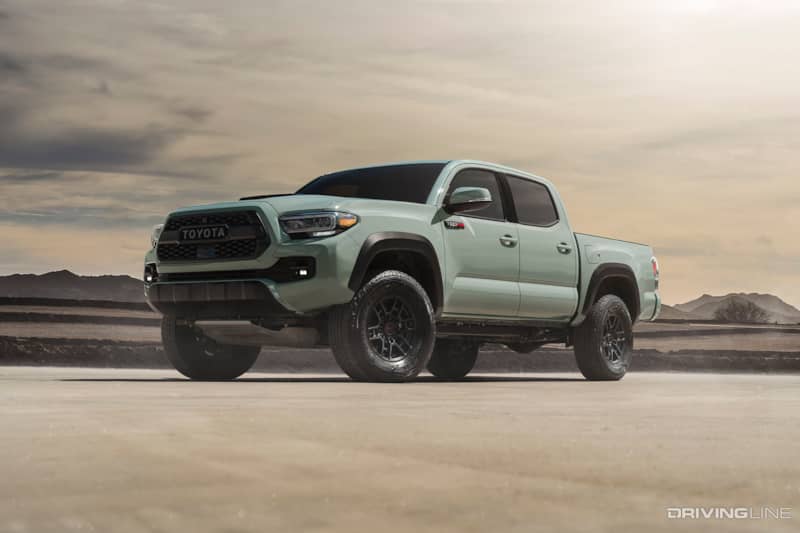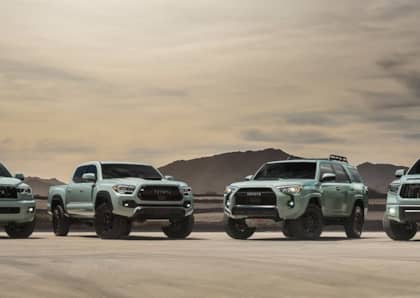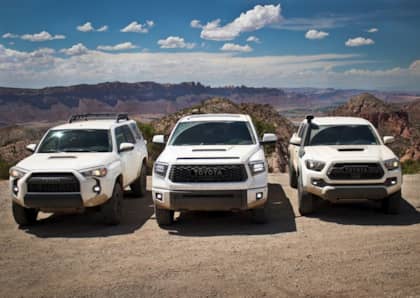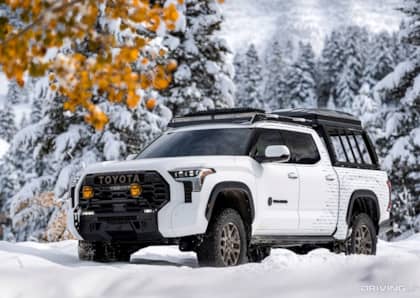If it Ain't Broke: Why Do Toyota's Outdated Trucks & SUVs Keep Getting More Popular?
Given their increasingly high sales numbers, the pickup truck and SUV segments in America are as competitive as they’ve ever been. Automakers are constantly trying to outdo each other when it comes to new tech, new mechanical features, horsepower and the latest in high-end materials.
Then there’s Toyota, which has one of the oldest and most “outdated” truck and SUV lineups of any automaker out there. For a quick refresher, here are the four models in particular that make up Toyota’s body-on-frame trucks and SUVs and how long they’ve been around.
Toyota Tundra
The current 2021 Toyota Tundra received a significant refresh seven years ago for the 2014 model year, but the underpinnings of the Tundra go back even further to the 2007 model year.

Unlike its half ton pickup competitors the Tundra currently offers just one engine choice, a naturally aspirated 5.7L V8 that was introduced with the debut of the second gen Tundra in ‘07. The six-speed automatic transmission has also been carried over since 2007.

Compared to its competitors from Ford, Chevy and RAM the Tundra is not only an entire generation or two behind, it also pales in comparison to the number of powertrain options available on those trucks, with no turbodiesel, no turbocharged gas engines and no larger V8 or more fuel efficient V6 options.

Yet despite its age and its lack of options, the Tundra has had no problem selling year after year, with annual sales hanging steady between 110,000 and 120,000 units for the last seven years.
Toyota Sequoia
You can’t talk about the Tundra without talking about it’s SUV platform-mate the Toyota Sequoia. Like the the Tundra has gone without major changes for well over a decade, with the current model first appearing for the 2008 model year.

The Sequoia is powered by the same single 5.7L V8 as the Tundra and has arguably changed even less exterior-wise over the years.

And while is sales volume is mere fraction of what the Tundra does, the Sequoia has also sold in steady number despite its aging bones, selling between 10 and 14,000 units during each year of the 2010s.

Toyota Tacoma
Next we get to Toyota’s most popular truck—the Tacoma. The Tacoma got a significant restyling and update for the 2016 model year and a slight facelift for the 2020 model year, but its basic structure isn’t far removed from what debuted way back in 2005.

The Tacoma has two different engine options: a base 2.7L four cylinder and a more common 3.5L V6, mated to either a six-speed manual or a six-speed automatic transmission. While the Tacoma has seen more changes than its larger counterpart, the Tundra, it is still seen by many as an older and less refined vehicle than its competition.

This is particularly true when it comes to powertrains. The Tacoma’s old but reliable engines lag behind the Chevy Colorado’s optional turbo diesel or the Ford Ranger’s 2.3L EcoBoost and 10-speed automatic.

Yet despite seeing no substantial updates for the last five years, you couldn’t tell that by its success. Tacoma sales have absolutely exploded recently, with a sales increase of around 50,000 units from 2017 to 2018. And last year, nearly 250,000 Tacomas were sold in the USA, the most successful in the model's history by far.

Toyota 4Runner
Finally we get to the 4Runner—which at the same time is one of Toyota’s oldest vehicles but also one that’s seen an incredible jump in sales in the last several years.

The current fifth generation 4Runner was introduced way back in 2009 for the 2010 model year, with an exterior facelift for the 2014 model year. Its powertrains have also remained the same, with the sole engine being a 270hp 4.0L V6.

It’s also one of the only new vehicles that still comes with a five-speed automatic rather than the six, seven, eight, nine and ten-speed gearboxes used in its competition. When compared to rivals like the Jeep Wrangler and the upcoming Ford Bronco, the 4Runner just does not seem competitive on paper.

Yet once again, its sales figures do not reflect that in any way. In 2013 when the fifth gen 4Runner was already well into its run, Toyota sold about 50,000 of them in the United States. And in 2019 when the platform had reached the decade mark? Over 131,000 units were sold.
Explaining the Popularity
So naturally the question is, despite all of Toyota’s body-on-frame trucks and SUVS having some of the oldest engineering and platforms on the market, why have they not just remained popular, but become even more popular as they’ve aged?

The most likely explanation may be the simple rise in popularity of all trucks and SUVs. With the American buyers embracing pickups and SUVs with open arms, it might just be natural to see Toyota’s trusted names selling in greater numbers.
And speaking of trust, Toyota trucks and SUVs also use their reliability to build incredible resale value and brand loyalty. A brand new Tacoma or 4Runner is far from cheap, but if you can drive it for several years and sell it for almost when you paid for it, it’s hard to fault anyone for buying one.

It could also be that the age and simplicity of these vehicles are a selling point. If dependability and toughness are your goal, Toyota’s bulletproof engines and proven platforms may have the edge over competitors with newer, better performing, but also less-proven technology.

Finally, there’s the coolness factor. Toyota trucks and SUVs are well-respected, and through its TRD Off-Road and TRD Pro branding, Toyota has cultivated a cool and adventurous image for its trucks. Combined with the growth in the off-road, overloading and “adventure” markets it’s easy to see why buyers have flocked to these “old” Toyotas.

The most likely explanation for the continued and rising popularity of what, on paper, should be obsolete vehicles is a combination of all these factors.
Whether you are a Toyota-lover or skeptic, it’s hard to argue with the sales numbers. Now the biggest question is when we’ll actually see next generations of these vehicles and how much Toyota will depart from its conservative, but proven, formula.
More From Driving Line
- Check out the latest iteration of the TRD Pro models for 2021 right here.











